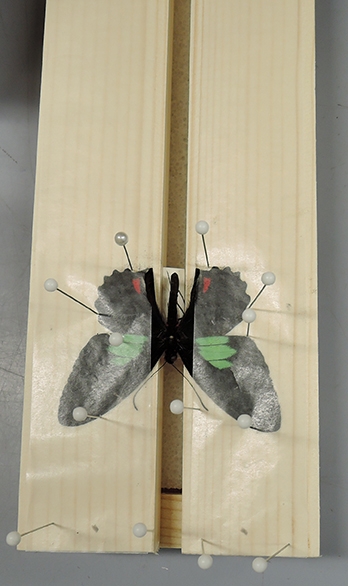
Visitors at the UC Davis Bohart Museum of Entomology open house on Sunday, Sept. 24 learned how to pin and spread butterflies and moths from entomologist Jeff Smith, curator of the museum's Lepidoptera collection.
The three-hour open house, held from 1 to 4 p.m. in Room 1124 of the Academic Surge Building, Crocker Lane, drew more than 100 visitors.
Smith curates the 400,000-specimen (and growing) collection. The entomologist has spread the wings of more than 200,000 butterflies and moths, or about 7000 a year, since 1988. “I do most of the work at my home (Rocklin), where I spread and identify specimens and add them to the museum collection,” he said.
An associate of the Bohart Museum and a member of the Bohart Museum Society and the Lepidopterists' Society, he was named a recipient of the UC Davis College of Agricultural and Environmental Sciences' "Friend of the College" award in 2015.
Smith covered several topics: labeling, relaxing dry specimens and spreading.
On labeling:
- Place the label next to the specimen as soon as it is spread
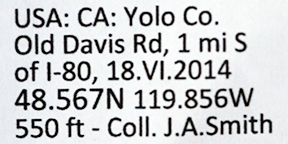 Example of a label
Example of a label - Use Calibri (body) font size 3.5 to minimize paper
- Use good paper, acid free, a bright white premium
To relax dry specimens, he recommends:
- Use large plastic tub, such as Rubbermaid, Tupperware
- Place 3/4 inch of coarse kitty litter in bottom, sloppy wet with water
- Use a round piece of polyethylene foam on top of the kitty litter to place specimens on
- To prevent mold, use a few crystals of chloro-cresol on poly foam (available from BioQuip Products)
- Specimens are usually relaxed within two to three days.
On spreading, he offered these tips:
- Have a variety of spreading boards with various gaps for different body sizes
- Use wax paper on top
- Use long (1.5 inches) big-headed pins
- Obtain insect pins--most often size #2 (#3 for large bodies, #0 for very small moths) from BioQuip Products or from the Bohart Museum store
- Place specimens on pin about 5/16" from the head (width of the top of the forceps) and make sure this is perpendicular both side to side, and front to back
- Pull forewing up so the bottom edge of the wing, just past horizontal
- Pull up hindwings appropriately
- Place big-headed pins AROUND the edge of the wing through the wax paper
- Support the body of a fresh specimen with 2 pins
- Move the antennae so they are parallel with the leading edge of the forewing
- Some kinds of Lepidoptera (skippers and sphinx moths in particular) may require a #3 insect pin through the wing at a major vein near the top of the wing to prevent the wing from slipping later
- If possible, leave specimens on the spreading board for up to three to weeks to ensure that they are completely dry
It's not easy to pin a butterfly. Just ask research entomologist Tom Zavortink, a Bohart Museum associate who told us: "Personally, I am astounded by the thousands upon thousands of butterflies and moths that Jeff has prepared for display or scientific study. This is no small task because butterfly and moth specimens are usually brought from the field in envelopes or boxes with their wings folded over their backs or around their bodies, and preparing them for display or scientific study involves relaxing them in a humid chamber so their wings and legs can be manipulated, carefully spreading open the wings, positioning them on a flat surface, and securing them in that position until the specimen dries again. This is an onerous task that many entomologists, myself included, shun because we don't have the time, manual dexterity, or patience it takes to prepare quality specimens."
Smith holds two bachelor's degrees from San Jose State University: one in biology and one in environmental health, both with concentrations in entomology. In between degrees, he served four years in the Air Force as a ground crew chief on B-52s and KC-135s. The Air Force awarded him the master crew chief certificate. He saw duty in Thailand and Guam.
Smith also engages in woodworking, a craft he learned from his father. He has made thousands of drawers for the Bohart Museum and “about half are from scratch,” he said. They include 150 drawers from recycled redwood decking and fencing. He makes and donates spreading boards for open houses and for UC Davis Entomology Club clinics.
The Bohart Museum, directed by Lynn Kimsey, UC Davis professor of entomology, is a world-renowned insect museum that houses a global collection of nearly eight million specimens. It also maintains a live “petting zoo,” featuring walking sticks, Madagascar hissing cockroaches, walking sticks, praying mantids, and tarantulas. A gift shop, open year around, offers T-shirts, sweatshirts, books, jewelry, posters, insect-collecting equipment and insect-themed candy.
The Bohart Museum's regular hours are from 9 a.m. to noon and 1 to 5 p.m. Mondays through Thursdays. The museum is closed to the public on Fridays, Saturdays and Sundays and on major holidays. Admission is free.
For more information, contact the bmuseum@ucdavis.edu or access the website or Facebook page.
Attached Images:
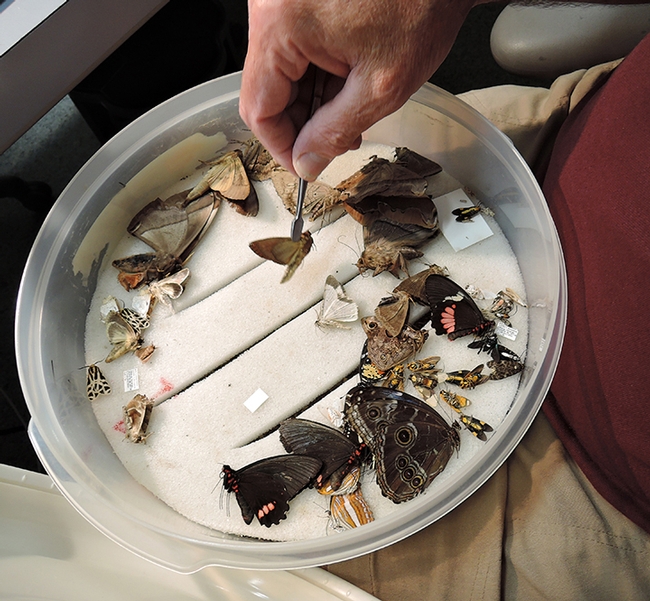
Entomologist Jeff Smith uses forceps to retrieve a specimen from his Lepitopdera tray during his demonstration at the Bohart Museum of Entomology open house. (Photo by Kathy Keatley Garvey)
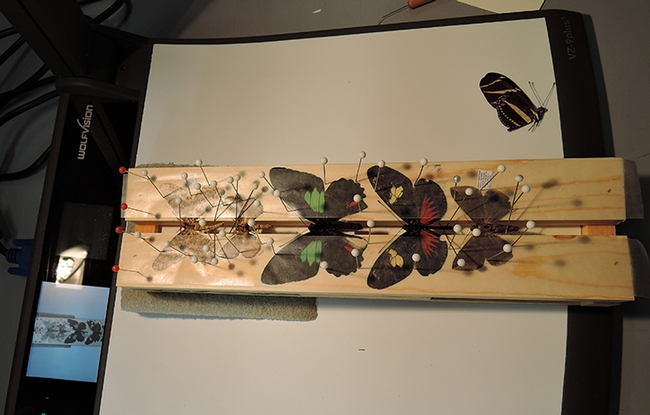
Pinning and spreading moths and butterflies is intricate work. (Photo by Kathy Keatley Garvey)
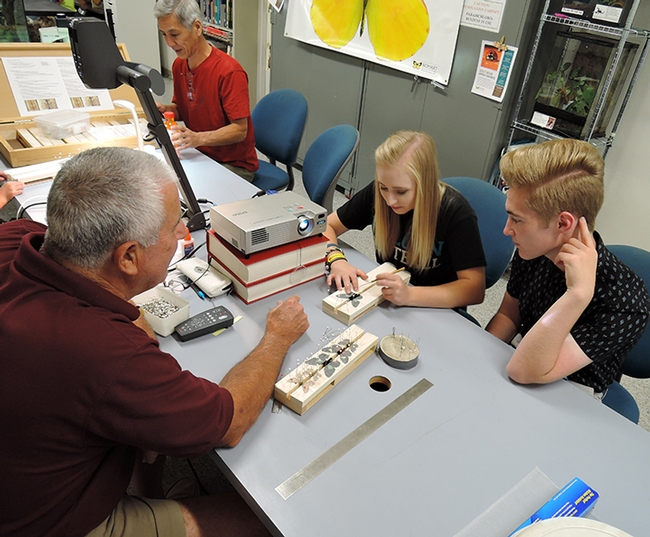
Folsom Lake College biology major Lauren Orris of Shingle Springs, a student of entomologist and assistant professor Fran Keller, pins a butterfly as her brother, Luke Orris, a high school student, watches. At left is entomologist Jeff Smith, who curates the Bohart's Lepitoptera collection. Both Lauren and Luke plan to enter the field of medicine. Keller, a Bohart Museum associate, received her doctorate in entomology from UC Davis.(Photo by Kathy Keatley Garvey)
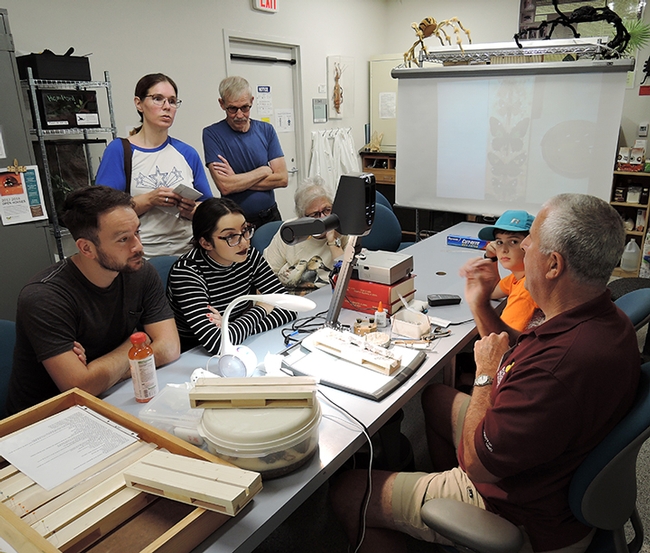
An interested group watches as entomologist Jeff Smith (right), curator of the Lepitopdera collection at the Bohart Museum, demonstrates how to prepare butterfly and moth specimens. (Photo by Kathy Keatley Garvey)
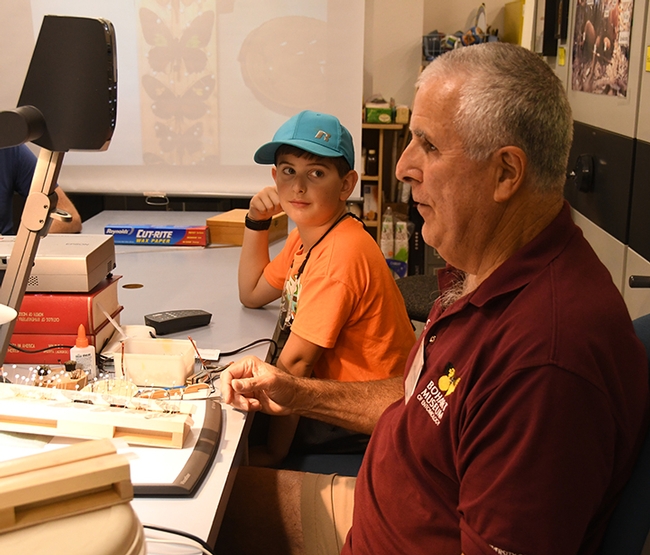
Delsin Russell, 7, of Vacaville, who wants to become an entomologist, is fascinated by the butterfly/moth demonstration by entomologist/curator Jeff Smith. (Photo by Kathy Keatley Garvey)
